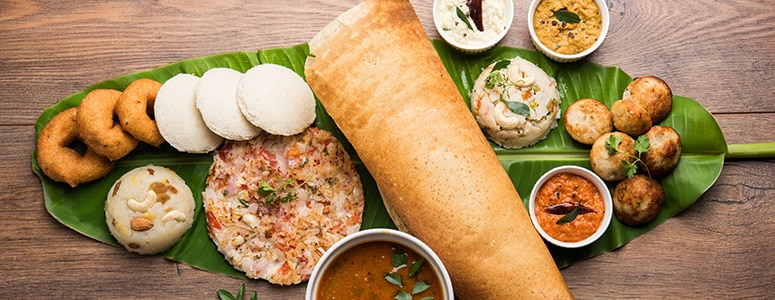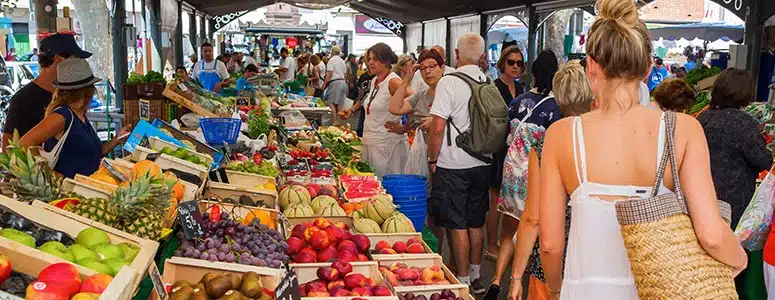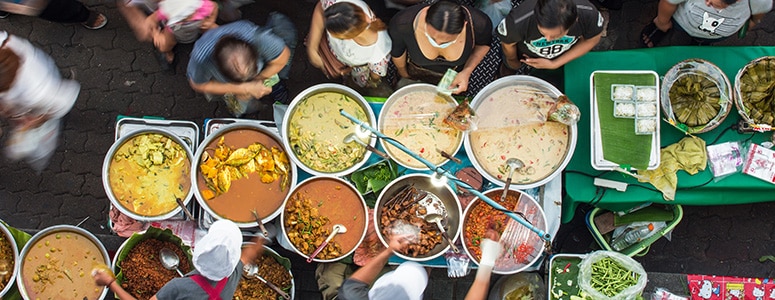As a life-long vegetarian and international traveler, I know how challenging it can be to find a good veg-friendly meal while abroad. Thankfully, traveling as a vegetarian or vegan is no longer as difficult as it once was just a couple of decades ago. We’ve gathered data from various trusted international sources to create this definitive “Vegan Travel Index” and we also include 17 tips for traveling vegans and vegetarians at the end of the article.

Please note: If you’d like to be the first to know when we update this study or when we publish new research, subscribe HERE ➜
37 Best (& Worst) Countries for Vegetarian & Vegan Travelers in 2022
Methodology
We looked at 39 countries with available data and created our Vegan Travel Index based on a total of seven ranking factors. We utilized a mixed methods research design to create the index. The highest possible score was 400 points and the lowest possible score was -200 points.
Positive Ranking Factors
- Vegetable, fruit, and legume supply quantity in kilograms per capita per year (each 0 to 100 Points) — These were our highest-weighted metrics to determine veg-friendly travel. Knowing what the locals are eating and what percentage of their diet is plant, fruit, and legume-based gives a good indication of what kind of options will be available for travelers. Additionally, this source had the most reliable and consistent data reported globally by the United Nations.
Source: UN Food and Agriculture Organization
- Percentage of the population that is vegetarian or vegan (0 to 50 Points) — We gave this metric less weight than you’d (likely) expect because our sources for this were a little inconsistent and some cases less-than-reliable. Some countries over-report, under-report, or simply unreliably report how many citizens are actually vegetarian. Two example countries that did have reliable data sources were India and the United States.
Source: Vegetarianism By Country – Wikipedia
- Number of vegan and vegetarian restaurants per 1 million annual tourists (0 to 50 Points) — We utilized the HappyCow.net website, an awesome resource with over 152,000 vegan and vegetarian restaurant listings worldwide. However, since the database is largely user-generated and mostly in English, we brought the number of HappyCow restaurants in each country to be in terms of frequency of 1 million tourists to get a more stable and reliable metric.
Source: HappyCow.net World Database
Negative Ranking Factors
- Meat and fish/seafood supply quantity in kilograms per capita per year (each 0 to -100 Points) — The quantity of meat, fish, and seafood supply were the only factors that received a full negative weight in our index. Some countries such as India had an incredibly low level of meat supply (4.11 kg/capita/year) whereas other countries like United States, Argentina, and Australia all had over 100 kg/capita/year. Again this source was from the United Nations database.
Source: UN Food and Agriculture Organization
Study Limitations: Due to budget constraints, the methodology used in our index does not sample the actual experiences of veg. tourists who have visited each country. Moreover, finding reliable data on veganism and vegetarianism around the world can be difficult, in part because all vegetarians and vegans are not the same. Additionally, some travelers may find one particular city to be very veg-friendly, but the country as a whole has generally terrible options, and vice-versa. We took a very individualized question (“what are the best and worst countries for vegetarian/vegan travelers?”) and attempted to quantify it on a larger scale, which will always have its limitations.
5 Best Countries for Vegans and Vegetarian Travelers in the World
Based on our findings, these are the five countries that are the most hospitable to vegan and vegetarian travelers along with their total scores in our study:
1. India (228 Points)
With an incredibly high rate of vegetarianism, low meat supply per person, and high supply of legumes, India is our top country for vegetarian travelers. What percentage of Indians are vegetarian? The answer, according to their Census Bureau, is an incredible 29%, giving them the highest percentage of vegetarians in the world. Many of India’s most famous dishes are vegetarian. Note: The Indian vegetarian diet is dairy-heavy and so finding vegan-friendly food can require some effort.
2. Mexico (135 Points):
There are not many strictly vegan or vegetarian restaurants in Mexico compared to their level of tourism, their high levels of fruit and legume consumption and the versatility of the country’s cuisine make it a great place for vegans and vegetarians to visit.
3. Brazil (133 Points):
While Brazilians do have a high rate of meat consumption and a comparatively low rate of vegetable consumption, they surprisingly have a very high number of vegan- and vegetarian-friendly restaurants per every 1 million tourists each year (849 restaurants for their 6.6 million annual tourists), making it one of the most vegetarian-friendly countries in the world.
4. Vietnam (123 Points):
Vietnam has a high vegetable and legume supply per resident as well as a moderately low meat supply. Vietnam also has a large Buddhist population, many of whom are lacto-vegetarian, making it a great destination for vegetarian travelers who want to enjoy the local cuisine.
5. Israel (105 Points):
Israel may surprise some as a vegetarian and vegan hotspot, but many say that Israel’s 13% vegetarian population has roots in the Jewish religion and interpretation of kosher practice. This means that there are many cruelty-free options for vegetarians and vegan travelers in Israel, and a great number of traditional Israeli dishes are meat-free.
The Worst Countries for Vegans and Vegetarian Travelers
The following five countries had the lowest vegan- and vegetarian-friendliness scores out of the 39 countries we analyzed:
1. Latvia (-11 Points):
Latvia has long been known as a meat-loving country, so it’s no surprise that it ranks at the bottom of our list. Just 3% of Latvians are vegetarians, and there are very few vegetarian-friendly restaurants.
2. Denmark (-5 Points):
Similar to Latvia, Denmark has a small percentage of vegetarians (3%). Traditional Danish cuisine contains a lot of meat and fish, making it difficult for vegans and vegetarians to find alternatives.
3. Lithuania (0 Points):
Lithuanian cuisine is known for its meat dishes, and the nation has the third-lowest fruit supply quantity per person on our list. There are also only 101 vegan-friendly restaurants in the country for its 6.1 million annual visitors.
4. France (3) Points:
When travelers think of French food, they generally think of rich meat and seafood dishes. The country also has a relatively small number of vegetarians (5.2% of the population) and few vegan-friendly restaurants.
5. Norway (6 Points):
Norwegians consume a lot of fish and seafood as well as red meat, along with a comparatively low amount of vegetables. Only 3% of Norwegians identify as vegetarian. It’s no wonder that Norway’s official dish, fårikål, is a mutton stew.
Types of Vegetarianism
There are many variations among those who call themselves “vegetarian” or “vegan”. Some people refrain from consuming or using animal products, while others may eat dairy or even fish or meat on occasion. These are the most common types of meat-free or meat-restricted diets:
- Vegan: Vegans do not consume any animal products or by-products, including meat, poultry, fish, dairy, eggs, honey, or gelatin. Many vegans also refrain from using or wearing animal by-products like leather, wool, silk, or beeswax.
- Raw vegans: This branch of veganism only eats uncooked foods that have no animal products or by-products. Some raw vegans will cook their food at low temperatures (usually under 104-115°F or 40-46°C).
- Fruitarian: Unsurprisingly, fruitarians are a variation of vegans, but who predominately eat fruit, and some also eat seeds, nuts, and legumes etc. Certain practitioners of this diet will only eat fruit that has fallen from the plant so as to not harm any living creature.
- Lacto-Vegetarian: These vegetarians do not eat any type of meat, fish, poultry, or eggs but generally consume dairy products like milk and cheese.
- Ovo-Vegetarian: Individuals who identify as ovo-vegetarian do not consume meat, fish, poultry, or dairy, but they do eat eggs and products containing eggs.
- Lacto-Ovo-Vegetarian: This is the most common type of vegetarian. These individuals do not consume meat, fish, or poultry but do eat eggs and dairy products.
A few other diets that aren’t truly vegetarians or vegans but are generally more plant-based diets:
- Flexitarian: Flexitarians are those who primarily follow a vegetarian diet but occasionally eat meat.
- Pescatarian: Pescatarians limit their meat consumption to fish and shellfish.
- Pollotarian: Pollotarians consume periodic poultry, but no seafood or red meat.
- Pegan: Peganism is a hybrid of veganism and paleo that focuses on the “hunter-gatherer” diet including fruit, nuts and seeds, vegetables, and occasional meat. The premise is to eat things that are wild caught like our ancestors did before farming was available but with a higher emphasis on the vegetarian diet rather than a more paleo meat heavy diet.
- Other variations: There are plenty of dietary variations among these, including gluten-free, dairy-free, kosher, paleo, and ketogenic, etc.
How many vegetarians are in the world?
A recent study estimated that 11% of global consumers are vegetarian, 3% are vegan, and 20% are flexitarian. India is one of the best-known vegetarian cultures with the official count being 29% of the population being strictly vegetarian. The practice of vegetarianism has been present in the country since ancient times, making travel in India great for those who do not consume meat.
While some people become vegans or vegetarians because they dislike the taste of meat, its negative health effects or they oppose the ways animals are treated, an increasing number are cutting out meat and dairy for environmental reasons. Replacing or reducing meat intake with vegetarian protein sources like lentils, beans, and nuts can help reduce our carbon footprint and greenhouse gas emissions. According to the Vegetarian Society, eating vegetarian for one year saves the same amount of emissions as taking a family car off the road for six months.
Whatever one’s reasons for becoming vegan or vegetarian may be, there are many countries around the world where travelers can find unparalled delicious meat-free food.
17 tips for traveling vegans & vegetarians
1. At restaurants, try ordering regular menu items without the meat
Many restaurants globally may not have the vegetarian selection you’re hoping for. However, often restaurants are willing to make their regular menu items sans meat. Some readily availabe meal options for requesting meat to be excluded include:
- Pasta dishes, like spaghetti and fettuccini
- Pizza (choose your own topings)
- Salads
- Tacos (with cheese and beans instead of any meat)
- Curries
- Rice and veggies
2. Consider bringing the essentials from home (and supplement with local vegetables and fruits)
This one is especially relevant for vegans whose diets can be quite a bit more restricted. Bring foods you’ll absolutely need, like favorite nut butter, snacks, supplements, and even vegan/vegetarian protein powder. Most places will have a selection of seasonal and regional vegetables and fruits but may lack vegan and vegetarian-friendly protein.
3. Google “health food stores” around where you’re staying
You might be surprised at what kind of options are actually available when you do a little digging. But even if you don’t find dedicated health food stores, regular stores should have a decent selection of vegan/veg options.
4. Websites like TripAdvisor and Yelp allow you to filter restaurants in your area by “vegetarian”
Doing some research ahead of time will ensure you and your travel companions know where to find the best veg-friendly restaurants at your destination. These days there are typically countless options in most major cities around the world.
5. Book accommodations that will allow you to cook
Having a full kitchen, kitchenette, and a fridge at your disposal will be a game-changer, particularly in countries with very limited meat-free options.
6. Bring Stasher bags and other eco-friendly food containers
These will allow you to bring nuts, dried fruits, and other snacks if you happen to be in an area where the majority of restaurants lack veggie options
7. Plan to spend a bit more
The majority of places around the world will have vegan and vegetarian options, but the more sophisticated and accommodating restaurants may come at a premium cost. Pad your budget with a bit of extra cash to make sure you can afford the foods that fit your dietary needs, even if they’re a bit more expensive. For example, our experience in Paris is that pretty much any upscale restaurant should be able to prepare you the most incredible veg-friendly meal you’ve ever had if you ask nicely.
8. Consider staying in a vegetarian hotel or a vegan hotel
A simple Google search of your destination should give you an idea if such hotels are available. You’d be surprised how many incredible locations around the world have these popular hotels.
9. Use technology to your advantage
Technology has made traveling as a non-meat eater easier than ever. There are apps that tell you how to communicate your veganism in over 100 languages, apps that tell you what vegetables and fruits are in season in your region, and even apps that let you find veg restaurants and products around the globe.
10. Do some searching online for national cuisine that typically doesn’t include meat
Knowing which of the famous cultural dishes can be made without meat ahead of time means you can still enjoy the local cuisine without worrying so much about the ingredients. Of course, you’ll still need to double-check with the wait staff before ordering anything.
11. The appetizer menu is a vegetarian’s best friend
Many of us have known this for a long time, but when in doubt study the appetizers as they are often more likely to be vegan/vegetarian if a restaurant has slim pickings. Instead of getting a main course, get several good-looking appetizers.
12. Use social media to your advantage
Often vegans and vegetarians will share restaurants and stores that carry veg options. Search on Instagram, Twitter or TikTok for #vegan and then whatever city or country you’re visiting. Variations can include hashtags like:
- #vegan(city name)
- #(city name)vegan
- #vegetarian(city name)
13. Find regional vegan travel guides
Go online and search “(destination) vegan guide” and you’ll likely find a few veg sources of inspiration for your travels. Plus, many guides will have the language to help you avoid certain ingredients and animal products.
14. Don’t forget to pack other cruelty-free vegan products
If using personal hygiene cosmetics, skincare, haircare and general products is important to you, be sure to bring them. Many countries will have a limited selection, if they carry them at all. It’s, therefore, better to bring what you need for your full trip than risk running out halfway through. Obviously being wise with baggage weight is also an important consideration and not bringing too many liquids in your carry-on bags as they won’t pass security in most countries.
15. Research the language ahead of time
Know how to communicate your dietary needs before you go so you’re not scrambling at the last minute. Being able to say “I don’t eat meat, fish, or poultry, do you have meat-free options that are vegetarian?” in the language of your destination will go a very long way. Also think about having it written down in the local language on a printout or saved on your phone can be very helpful!
16. Research vegetarian communities in your destination
Often you’ll find vegan and vegetarian communities on Facebook, Reddit, MeetUp, or other social platforms. Connecting with other vegetarians in your destination is a great way to find local restaurants or tips for eating animal-free in your travels.
17. Double check with the server that there are no meat or animal products in your food
We’ve all probably been in that situation where you ask if something has meat and are told “no”… but it has fish. You can always confirm politely with the waitstaff to ensure that there are no meat or animal products in your food before consuming. It’s better to be safe and double check!







